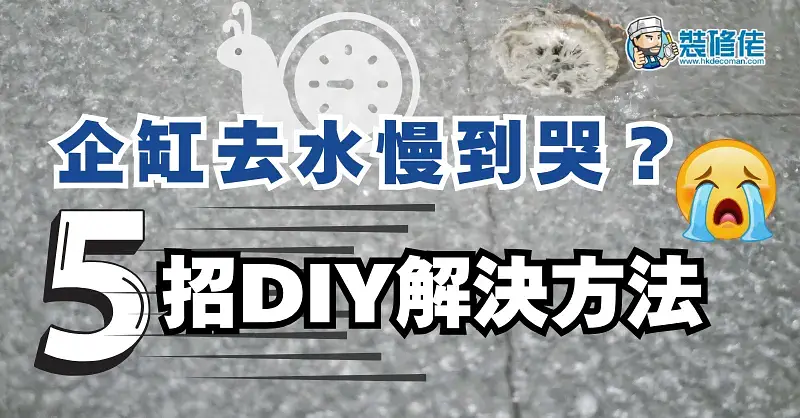Shower Curb Drainage: Causes and DIY Fixes
Listen to the blog audio:

Drainage is a critical aspect of bathroom design. Proper drainage design prevents water flow issues and avoids flooding. Slow drainage on shower curbs can cause inconvenience and even hygiene problems. HK DecomAN explores the main causes of poor drainage on shower curbs and provides simple and effective DIY solutions to tackle this problem.

Key Elements of Effective Drainage on Shower Curbs
Good drainage design for shower curbs includes the following key elements:
Slope Design
Shower curbs should have a slight slope to allow water to flow naturally towards the drain. Too little slope can cause water to pool, increasing the risk of mildew growth, while too much slope can be uncomfortable to stand on. Precise calculations of the curb height and slope are necessary to ensure effective drainage.

Odor Trap Installation
Odor traps, also known as P-traps or U-traps, are installed between the drain and the sewage pipe. They create a water seal to prevent odors from entering the bathroom. Common types include U-shaped and bottle-shaped traps, often equipped with an "anti-siphon valve" to balance air pressure and prevent the water seal from being sucked out during flushing.
Waterproofing
Waterproofing is essential in shower curb drainage design. It should be evenly applied between the curb and the wall, filling any tile gaps. After applying the waterproofing layer, contractors perform a water storage test to confirm there are no leaks.
Drain Selection
Drain selection should consider the overall layout of the bathroom. Choosing the right drain model ensures efficient drainage. Additionally, the diameter and design of the drain should accommodate the water flow rate in the bathroom to prevent blockages due to excessive or slow water flow.

Reasons for Slow Drainage in Platform Beds
Clogged drain
During the use of the bathroom, hair, soap scum, sebum, and other debris can enter the drain along with the water flow. Over time, this buildup can lead to a clogged drain, affecting not only the drainage speed but also potentially causing unpleasant odors.
Prevention method: Install a filter at the drain outlet and regularly clean out debris to reduce the likelihood of clogs.

Accumulation of dirt and grime
The ingredients in shower gel and shampoo can combine with skin oils, forming thick, sticky grime, especially inside the pipes. If not cleaned promptly, this grime will harden over time, severely impacting drainage efficiency.
Prevention method: Regularly flush the drain pipes with cleaning agents and inspect for grime buildup.

Air admittance valve blockage
Blockage of the air admittance valve affects the air pressure balance for drainage, resulting in poor water flow. This is usually caused by debris or dirt buildup inside the valve.
Prevention method: Regularly inspect the base box of the air admittance valve, clean any sediment, and ensure it is clear.
Insufficient floor slope
If the floor slope does not meet the standard, water flow will be affected, and flooding may occur. The ideal slope should be maintained between 1% and 3%.
Solution: If the slope is insufficient, you may need to consult a professional to redesign or adjust the floor to achieve optimal drainage.
Waterproofing issues
Damaged or improperly designed waterproofing can cause water to seep into the ground, affecting the normal operation of the drainage system.
Solution: Promptly inspect and repair the waterproofing layer to ensure its integrity.

DIY Solutions
Check the air admittance valve
Remove the floor drain and inspect the air admittance device for any blockage by hair or debris. If found, clear these obstructions to improve drainage.
Use a plumbing snake
If there is no blockage in the air admittance area, you can use a plumbing snake. Align the snake with the drain opening and continuously turn the wheel until you dislodge any blockages in the pipe. Then, turn the wheel in the opposite direction to retract the snake and flush with ample clean water.

Use a toilet plunger
If the drain snake is too short to reach the clog, you can use a bowl pump or a suction pump to help dislodge the blockage and push it towards the main drain.

Add baking soda
Baking soda can effectively dissolve grease clogs. Mix 200 grams of baking soda with a large amount of hot water and pour it down the drain to clear the blockage.
Replace the air-tight floor drain
If the air-tight floor drain is causing the drainage problem, consider replacing it with a regular floor drain to improve drainage.

Get free quotes for your renovation for different types of properties:
Public and Subsidized Housing|https://decoman-publichousing.com/
Private Apartments|https://decoman-privatehousing.com/
New Properties|https://decoman-newproperties.com/
Walk-up Apartments|https://decoman-tenement.com/
===============================================
This article and its images are provided by Mr. Deco, our column writer.
